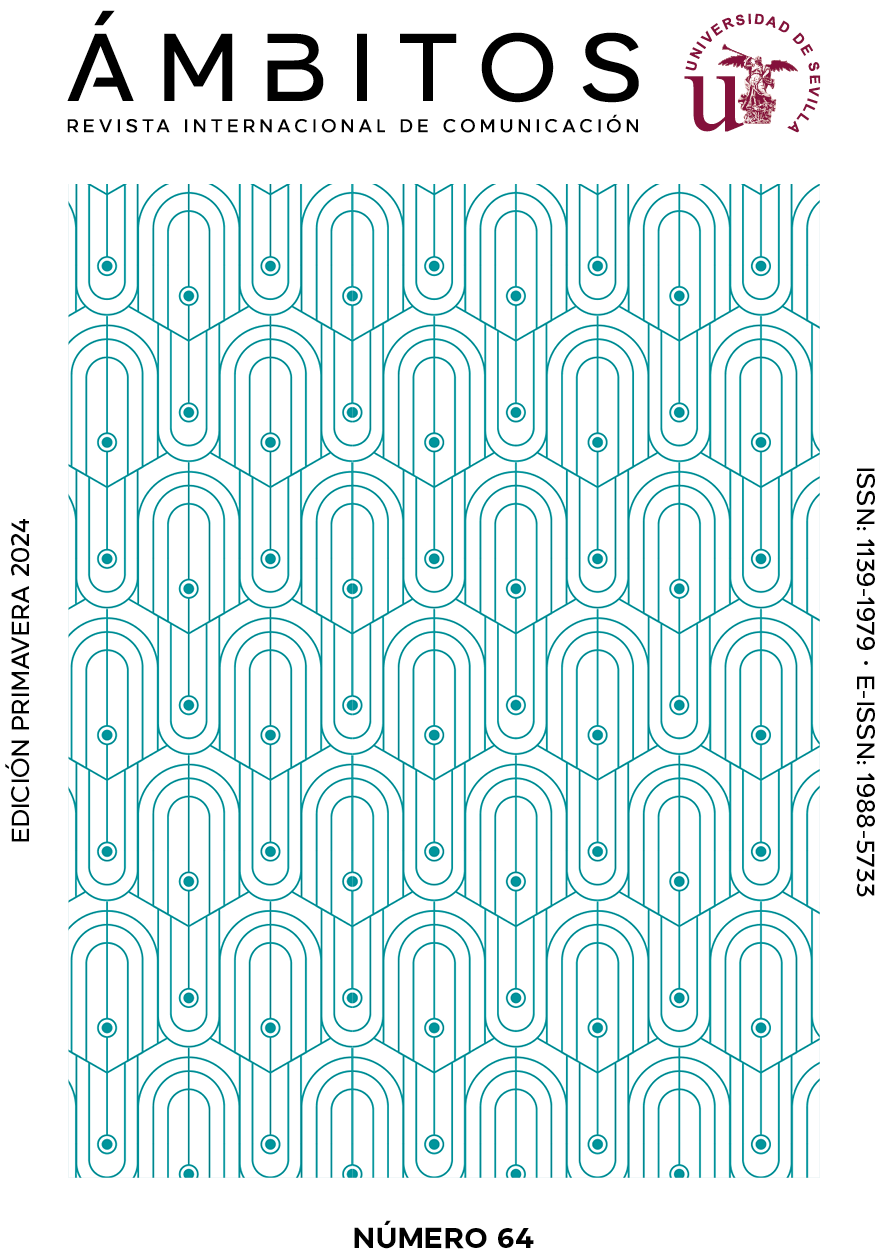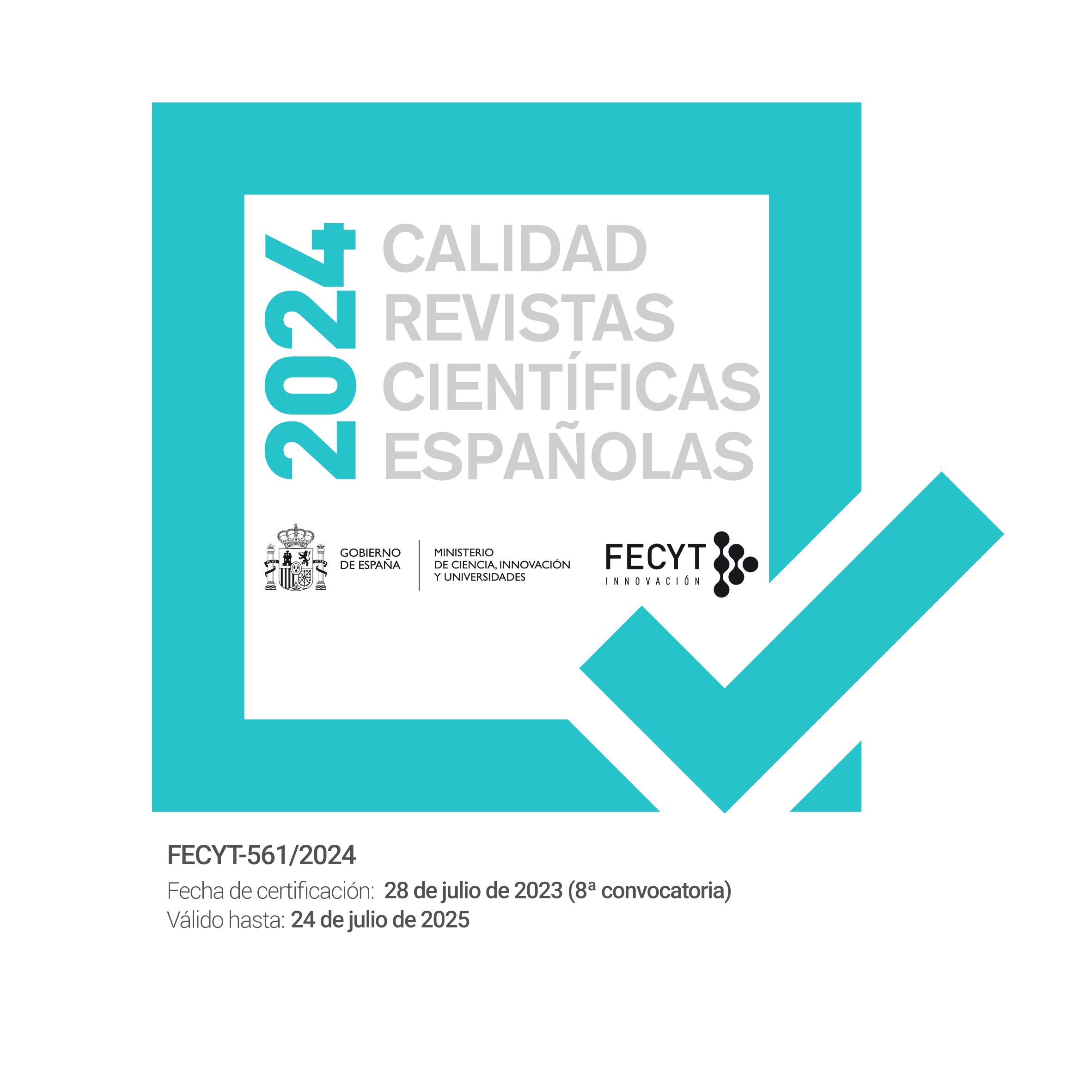Visual framing of the 2022 Andalusian elections: Comparative analysis in the regional and national press
DOI:
https://doi.org/10.12795/Ambitos.2024.i64.04Keywords:
Political communication, electoral campaigns, Andalucía, visual framing, pressAbstract
The dominance of image in communication has become a central aspect in electoral campaigns. In the tradition of studies on the effects of media on campaigns, researchers had adopted, framing theory as one of the explanatory paradigms. These works focused their analysis on the textual elements of the information. However, the prevalence of the image in communication has opened up a growing interest in “visual framing”, which incorporates the study of images and their meanings. This work contributes to deep into this theory and its application to the regional press. The objective of this study is to compare the visual, frames used by the national and regional press in an electoral contest, the 2022 Andalusian elections. Through a content analysis, and in accordance with the coding of visual frames of political candidates used by Grabe and Bucy (2009) -ideal candidate, populist campaigner, and sure loser-, the article analyze the type of campaign portrayed by the media. It examines the photographs of the candidates published during the election campaign (June 3-17, 2022) by four Spanish newspapers: the two national newspapers with the largest number of readers (El País and El Mundo) and the two most read Andalusian regional newspapers (Ideal de Andalucía and Sur). Results confirm the relevance of the visual frames, but there are no significant differences between regional and national press, and the most relevant frame is in both cases the ideal candidate.
The objective of this study is to compare the visual frames used by the national and regional press in an electoral contest, the 2022 Andalusian elections. Through a content analysis, and in accordance with the coding of visual frames of political candidates used by Grabe and Bucy (2009) -ideal candidate, populist campaigner, and sure loser-, the article analyze the type of campaign portrayed by the media. It examines the photographs of the candidates published during the election campaign (June 3-17, 2022) by four Spanish newspapers: the two national newspapers with the largest number of readers (El País and El Mundo) and the two most read Andalusian regional newspapers (Ideal de Andalucía and Sur).
The results of the analysis validate the importance of visual frames, the differences between the national and regional press, and the types of candidates that images profile
Downloads
References
Barrett, A.W., & Barrington, L.W. (2005). Bias in newspaper photograph selection. Political Research Quarterly, 58(4), 609–618. https://doi.org/10.1177/106591290505800408
Berganza, M.R., De Miguel, R., & Domínguez, M.Á.C. (2011). La prensa gratuita ante las elecciones generales de España del 9 de marzo de 2008: cobertura, politización y frames en contraposición a la prensa de pago. Communication & Society, 24(1), 35-62. http://hdl.handle.net/10115/5534
Boorstin, D. (1992). The Image: A Guide to Pseudo-Events in America. Vintage.
Borah, P. (2009). Comparing visual framing in newspapers: Hurricane Katrina versus tsunami. Newspaper Research Journal, 30(1), 50-57. https://doi.org/10.1177/073953290903000106
Coleman, R. (2010). Framing the pictures in our heads: Exploring the framing and agenda-setting effects of visual images. In P. D’Angelo & J.A.Kuypers (eds.). Doing news framing Analisis: Empirical and theoretical perspectives (pp. 323–261). Routledge. https://doi.org/10.4324/9780203864463
Coleman, R., & Baning, S. (2006). Network TV news’ affective framing the presidential candidates: Evidence for a second-level agenda-setting effect through visual framing. Journalism and Mass Communication Quarterly, 83(2), 313–328. https://doi.org/10.1177/107769900608300206
Conners, J. L. (2016). Visual framing of 2014 US senate campaign: Conflict bias in news coverage. In Communication and midterm elections (pp. 115-130). Palgrave Macmillan.
De-Vreese, C., & Tobiasen, M. (2007). Conflict and identity: explaining turnout and anti-integrationist voting in the Danish 2004 elections for the European Parliament. Scandinavian Political Studies, 30(1), 87-114. https://doi.org/10.1111/j.1467-9477.2007.00174.x
Entman, R.M. (1991). Framing US coverage of international news: Contrasts in narratives of the KAL and Iran air incidents. Journal of Communication, 41(4), 6–27. https://doi.org/10.1111/j.1460-2466.1991.tb02328.x
Fahmy, S., Kelly, J. D., & Kim, Y. S. (2007). What Katrina revealed: A visual analisis of the hurricane coverage by news wires and U.S. newspapers. Journalism and Mass Communication Quarterly, 84(3), 546–561. https://doi.org/10.1177/107769900708400309
Fahmy, S., Cho, S., Wanta, W., & Song, Y. (2009). Visual agenda-setting after 9/11: Individuals’ emotions, image recall, and concern with terrorism. Visual Communication Quarterly, 13(1), 4–15. https://doi.org/10.1207/s15551407vcq1301_2
Forgette, R. (2018). News grazers: media, politics, and trust in an information age. CQ Press.
Giannakopoulos, G. (2016). Depicting the pain of others: Photographic representations of refugees in the Aegean Shores. Journal of Greek Media and Culture, 2(1), 103-113. https://doi.org/10.1386/jgmc.2.1.103_1
Gibson, R. Zillmann, D., & Sargent, SL. (1999). Effects of photographs in news-magazine reports on issue perception. Media psychology, 1(3), 207-228. https://doi.org/10.1207/s1532785xmep0103_2
Gitlin, T. (1980). The whole world is watching, University of California Press, Berkeley
Grabe, M. E., & Bucy, E. P. (2009, 2011). Image bite politics: News and the visual framing of elections. Oxford University Press.
Graber, D. A. (1989). Content and meaning: Whas it all about. American Behavioral Scientist, 33(2), 144-152 https://doi.org/10.1177/0002764289033002004
Greenberg, J. (2002). Framing and temporality in political cartoons: A critical analysis of visual news discourse. Canadian Review of Sociology, 39(2), 181–198. https://doi.org/10.1111/j.1755-618X.2002.tb00616.x
Greenwood, K., & Jenkins, J. (2015). Visual framing of the Syrian conflict in news and public affairs magazines. Journalism Studies, 16(2). 207-227. https://doi.org/10.1080/1461670X.2013.865969
Hoyer, A. (2016). Spanish News Framing of the Syrian Refugee Crisis. WWU Honors Program Senior Projects. Paper 26. http://cedar.wwu.edu/wwu_honors/26
Karabiyik, A. Ç. (2021). Visual Framing of Political Candidates: Case Study of the 2014 Turkish Presidential Election Campaign. Central European Journal of Politics, 7(1), 1-29. https://doi.org/10.24132/cejop_2021_3
Lakoff, G. (2004). Don’t think of an elephant: Progressive values and the framing wars: a progressive guide to action. White River Junction, VT: Chelsea Green Publishing.
Lippmann, W. (2017). Public opinion. Routledge.
López del Ramo, J. (2010a). El tratamiento fotoperiodístico en las portadas de los diarios digitales. Propuesta y aplicación de un modelo de análisis. Doxa Comunicación, (11), 77-99. https://doi.org/10.31921/doxacom.n11a4
López Del Ramo, J. (2010b). Configuración y contextualización de las galerías fotográficas en los diarios on-line. Propuesta de analítica aplicada. El profesional de la información, 19(5), 469-475. https://doi.org/10.3145/epi.2010.sep.04
López del Ramo, J., & Humanes, M. L. H. (2016). Análisis del framing visual y sus componentes en el tratamiento fotográfico de la crisis de los refugiados sirios en medios de prensa internacional. Scire: representación y organización del conocimiento, 87-97. https://doi.org/10.54886/scire.v22i2.4395
López-Escobar, E., Sádaba, T., & Zugasti, R. (2009). Election Coverage in Spain: From Franco’s Death to the Atocha Massacre. In The handbook of election news coverage around the world (pp. 175-191). Routledge. https://doi.org/10.4324/9780203887172
Luntz, Frank (2007). Words that Work. Hyperion.
Messaris, P., & Abraham, L. (2001). The role of images in framing news stories. In S.D. Reese et al. (eds.). Framing public life: Perspectives on media and our un-derstanding of the social world (pp. 215–226). Routledge.
Moriarty, S., & Shaw, D. (1995). An Antiseptic War: Were News Magazine Images of the Gulf War Too Soft? Visual Communication Quarterly, 2(2), 4-11. https://doi.org/10.1080/15551393.1995.10387520
Muñiz, C., Saldierna, A. R., & Marañón, F. J. (2018). Framing of electoral processes: The stages of the campaign as a moderator of the presence of political frames in the news. Palabra Clave, 21(3), 740-771. http://doi.org/10.5294/pacla.2018.21.3.5
Muñiz, C. Igartua, J.J., & Otero, J.A. (2006). Imágenes de la inmigración a través de la fotografía de prensa. Un análisis de contenido. Comunicación y Sociedad, 19(1), 103-128. https://doi.org/10.15581/003.19.36315
Muñoz, C. L., & Towner, T. L. (2017). The image is the message: Instagram mar keting and the 2016 presidential primary season. Journal of political marketing, 16(3-4), 290-318. https://doi.org/10.4324/9781351105521
Pantti, M. (2016). Seeing and not seeing the Syrian crisis: New visibility and the visual framing of the Syrian conflict in seven newspapers and their online editions. JOMEC journal, 4, 1-22. https://doi.org/10.18573/j.2013.10259
Pinkleton, B. E., Austin, E. W., Zhou, Y., Willoughby, J. F., & Reiser, M. (2012). Perceptions of News Media, External Efficacy, and Public Affairs Apathy in Political Decision Making and Disaffection. Journalism and Mass Communication Quarterly, 89(1), 23–39. https://doi.org/10.1177/1077699011428586
Reese, S. D., Gandy Jr, O. H., & Grant, A. E. (Eds.). (2001). Framing public life: Perspectives on media and our understanding of the social world. Routledge.
Rodriguez, L., & Dimitrova, D. V. (2011). The levels of visual framing. Journal of visual literacy, 30(1), 48- 65. https://doi.org/10.1080/23796529.2011.11674684
Sádaba, T., Rodríguez, J., & Bartolomé, M. (2012). Propuesta de sistematización de la teoría del framing para el estudio y praxis de la comunicación política. Observatorio (OBS*) journal, 2(6), 109-126. https://doi.org/10.15847/obsOBS622012540
Sádaba, T. (2008). Framing: el encuadre de las noticias. El binomio terrorismo-medios. La Crujía.
Salazar-Sutil, N. (2009). What’s in your wardrobe, Mr. Morales? A study in political dress. Popular Communication, 7(2), 63-78. https://doi.org/10.1080/15405700902776461
Schwalbe, C. (2013). Visually framing the invasion and occupation of Iraq in Time, Newsweek, and US News and World Report. International Journal of Communication, (7), 24 https://ijoc.org/index.php/ijoc/article/view/924/852
Steffan, D. (2020). Visual self-presentation strategies of political candidates on social media platforms: A comparative study. International Journal of Communication, (14), 23. http://dx.doi.org/10.17169/refubium-29831
Streitmatter, R. (1988). The rise and triumph of the White House photo opportunity. Journalism Quarterly, 65(4), 981-985. https://doi.org/10.1177/107769908806500423
Tankard, J.W. (2001). The empirical approach to the study of media framing. In S.D. Reese, O.H. Gandy & A.E. Grant (eds.), Framing public life: Perspectives on media and our understanding of the social world (pp. 95-105). Routledge
Uluçay, D. M., & Melek, G. (2021). Self-presentation strategies and the visual framing of political leaders on Instagram: evidence from the eventful 2019 Istanbul mayoral elections. Visual Communication. https://doi.org/10.1177/14703572211057595
Valentino, N., A. Buhr, & Beckmann, M. (2001). When the frame is the game: Revisiting the impactvof strategic campaign coverage on citizens information retention. Journalism and Mass Communication Quarterly, (78), 93 – 112. https://doi.org/10.1177/107769900107800107
Valera Ordaz, L. (2016). El sesgo mediocéntrico del framing en España: una revisión crítica de la aplicación de la teoría del encuadre en los estudios de comunicación. ZER: Revista de estudios de Comunicación, 21(41). https://doi.org/10.1387/zer.17259
Waldman, P., & Devitt, J. (1998). Newspaper photographs and the 1996 presidential election: The question of bias. Journalism and Mass Communication Quarterly, 75(2), 302–311. https://doi.org/10.1177/107769909807500206
Wanta, W. (1988). The effects of dominant photographs: An agenda-setting experiment. Journalism quarterly, 65(1), 107-111. https://doi.org/10.1177/107769908806500114
Published
How to Cite
Issue
Section
License
Copyright (c) 2024 Miguel Ángel Sánchez de la Nieta, Teresa Sádaba Garraza

This work is licensed under a Creative Commons Attribution-NonCommercial-ShareAlike 4.0 International License.
Ámbitos. Revista Internacional de Comunicación is an open access journal, which means that all content is freely available at no charge to the user or their institution. Users may read, download, copy, distribute, distribute, print, search or link to the full text of articles, or use them for any other lawful purpose, without seeking prior permission from the publisher or author. This definition of open access is in accordance with the Budapest Open Access Initiative (BOAI).

Unless otherwise noted, all content in the electronic edition is distributed under a "Creative Commons Attribution-NonCommercial-ShareAlike 4.0 International License". You can consult the informative version and legal text of the licence here. This should be expressly stated in this way where necessary.
In case of acceptance of the manuscript, the authors cede the rights of the work for its publication to Ámbitos. Revista Internacional de Comunicación under the Attribution-NonCommercial-ShareAlike 4.0 International license contract (CC BY-NC-SA 4.0). The authors retain copyright and third parties are authorised to copy, distribute and make use of the work, provided they comply with the terms and conditions set out in the licence
- Cite the authorship and the original source of publication (journal, publisher and URL of the work).
- Do not use them for commercial purposes.
- If you remix, transform or create from the material, you must release your contributions under the same license as the original.
More information can be found at https://creativecommons.org/licenses/by-nc-sa/4.0/deed.es


















